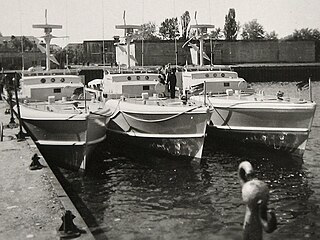 W
WThe 1953 Avro Lincoln shootdown incident was the shooting down of a British Avro Lincoln four-engined bomber which had intruded into East German airspace during a training mission on 12 March 1953. While the aircraft was flying on the Hamburg-Berlin air corridor over East Germany it was shot down by a MiG 15 Soviet fighter.
 W
WHMS Defender is the fifth of the Type 45 or Daring-class air-defence destroyers built for the Royal Navy. She is the eighth ship to bear the name. Construction of Defender began in 2006, and she was launched in 2009. The ship completed her first sea trials in October and November 2011, and was commissioned during March 2013.
 W
WThe British Frontier Service was a British government organisation that was responsible for border monitoring duties in West Germany between 1946 and 1991. Its personnel served on Germany's international borders with Denmark, the Netherlands and Belgium before focusing on the inner German border. It was charged with a number of tasks, including assisting the movements of British military personnel and their dependents, monitoring the border regions and helping to defuse border incidents. It was ultimately disbanded following German reunification.
 W
WLieutenant-Commander Lionel Kenneth Phillip Crabb,, known as Buster Crabb, was a Royal Navy frogman and diver who vanished during a reconnaissance mission for MI6 around a Soviet cruiser berthed at Portsmouth Dockyard in 1956.
 W
WHANDEL was the code-name for the UK's national attack warning system in the Cold War. It consisted of a small console with two microphones, lights and gauges. The reason behind this was to provide a back-up if anything failed.
 W
WRAF High Wycombe is a Royal Air Force station, situated in the village of Walters Ash, near High Wycombe in Buckinghamshire, England. It houses Headquarters Air Command, and was originally designed to house RAF Bomber Command in the late 1930s. The station is also the headquarters of the European Air Group and the United Kingdom Space Command.
 W
WUSS James Madison (SSBN-627), the lead ship of her class of ballistic missile submarine, was the second ship of the United States Navy to be named for James Madison (1751–1836), the fourth President of the United States (1809–1817).
 W
WOperation Jungle was a programme by the British Secret Intelligence Service (MI6) early in the Cold War from 1949 to 1955 for the clandestine insertion of intelligence and resistance agents into Poland and the Baltic states. The agents were mostly Polish, Estonian, Latvian and Lithuanian exiles who had been trained in the United Kingdom and Sweden and were to link up with the anti-Soviet resistance against the communist governments. The naval operations of the programme were carried out by German crew-members of the German Mine Sweeping Administration under the control of the Royal Navy. The American-sponsored Gehlen Organization also got involved in the draft of agents from Eastern Europe. However, the MGB penetrated the network and captured or turned most of the agents.
 W
WRoyal Air Force Fylingdales or more simply RAF Fylingdales is a Royal Air Force station on Snod Hill in the North York Moors, England. Its motto is "Vigilamus". It is a radar base and is also part of the Ballistic Missile Early Warning System (BMEWS). As part of intelligence-sharing arrangements between the United States and United Kingdom, data collected at RAF Fylingdales are shared between the two countries. Its primary purpose is to give the British and US governments warning of an impending ballistic missile attack. A secondary role is the detection and tracking of orbiting objects; Fylingdales is part of the United States Space Surveillance Network. As well as its early-warning and space-tracking roles, Fylingdales has a third function – the Satellite Warning Service for the UK. It keeps track of spy satellites used by other countries, so that secret activities in the UK can be carried out when they are not overhead. The armed services, defence manufacturers and research organisations, including universities, take advantage of this facility.
The Royal Observer Corps (ROC) was a civil defence organisation intended for the visual detection, identification, tracking and reporting of aircraft over Great Britain. It operated in the United Kingdom between 29 October 1925 and 31 December 1995, when the Corps' civilian volunteers were stood down. Composed mainly of civilian spare-time volunteers, ROC personnel wore a Royal Air Force (RAF) style uniform and latterly came under the administrative control of RAF Strike Command and the operational control of the Home Office. Civilian volunteers were trained and administered by a small cadre of professional full-time officers under the command of the Commandant Royal Observer Corps; latterly a serving RAF Air Commodore.
 W
WRoyal Observer Corps Monitoring Posts are underground structures all over the United Kingdom, constructed as a result of the Corps' nuclear reporting role and operated by volunteers during the Cold War between 1955 and 1991.
 W
WThe Royal Observer Corps Orlit Post is an observation post used by the Royal Observer Corps during the Cold War to recognise enemy aircraft. Many Orlit Posts can be found near ROC Monitoring Posts.
 W
WBetween 1948 and 1992, personnel and aircraft of the United States Air Force (USAF) Strategic Air Command (SAC) were routinely deployed to bases in England. An informal agreement to base SAC bombers in the UK was reached between US General Carl Spaatz, and Marshal of the Royal Air Force (RAF) Lord Tedder, in July 1946. At that time there were only three bases in the UK deemed suitable for operating Boeing B-29 Superfortresses: RAF Lakenheath, RAF Marham and RAF Sculthorpe. These were airbases that had been extended during World War II when there were plans to use B-29s against Germany. When the Berlin Blockade began in June 1948, two B-29 groups deployed to the UK, but neither was equipped with Silverplate bombers capable of carrying nuclear weapons. Nuclear-capable Boeing B-50 Superfortress bombers began deploying in 1949, and nuclear bombs followed in 1950.